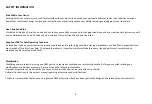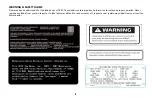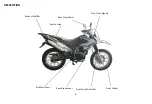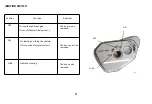
SAFETY INFORMATION
Important Safety Information
Take responsibility for your own safety and understand the challenges you can meet while riding.
There is much that you can do to protect yourself when you ride. You'll find many helpful recommendations throughout this manual. The
following are a few that we consider most important.
Always Wear a Helmet
Helmets significantly reduce the number and severity of head injuries
, s
o always wear an approved motorcycle helmet and make sure your
passenger does the same. We also recommend that you wear eye protection, motorcycle boots, gloves, and other protective gear.
Learning how to ride your motorcycle
Take time to become familiar with how this motorcycle works and handles. Practice in a safe area until you build your skills and get accustomed
to the motorcycle's size and weight.
Because many accidents involve inexperienced or untrained riders, we urge all riders to take a certified course approved safety learning class.
Developing off-road riding skills is a gradual step-by-step process. Start by practicing at low speeds in a safe area and slowly build your skills.
On-Road Riding
The most frequent motorcycle collision happens when a car turns left in front of a motorcycle. Another common situation is a car moving
suddenly into your lane.
Always pay attention to other vehicles around you, and do not assume that other drivers see you. Be prepared to stop quickly or make an
evasive maneuver.
Make yourself more visible, wear bright reflective clothing, position yourself so other drivers can see you, signal before turning or changing
lanes, and use your horn when it will help others notice you.
Be Alert for Off-Road Hazards
The terrain can present a variety of challenges when you ride off-road. Continually "read" the terrain for unexpected turns, drop-offs, rocks,
ruts and other hazards. Always keep your speed low enough to allow time to see and react to hazards.
11






































